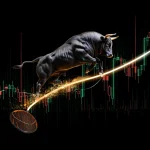Singularity at the Edge: Where Fear Becomes Pattern
Apr 30, 2025
Trapdoor: open. You thought you stood on solid ground. You thought the rules were fixed, that numbers would cradle you, that the past was prologue and the future a polite extension of yesterday. But the market is not a gentle continuum. It is a quantum landscape, a swarm of probabilities, uncertainty folded upon itself. The moment complacency whispers comfort, it vanishes: price slips, confidence shatters, reality bends. To predict market behaviour is not to plot a line—it is to listen to the tremors beneath the graph, the echoes in the void, the ghostly harmonics of human panic and euphoria. Step wrong, and you are gone, swallowed by the singularity of collective fear. Step right, and you become the anomaly, the outlier who survives collapse and rides the shockwave to new ground. The difference is not logic, but perception. The difference is not knowledge, but the ability to sense when the world is about to lurch beneath your feet. In this crucible, every tool is a weapon, every signal a cipher. Technical and fundamental analysis are not guides—they are compasses spinning in a hurricane. The art is in reading the distortion.
Schrödinger’s Price: Technical Analysis as Probability Cloud
A chart is a crime scene, riddled with evidence and misdirection. Candlesticks flicker, shadows stretch, gaps yawn open—a two-dimensional projection of a four-dimensional war. The crowd believes in patterns, in Fibonacci, in breakout and breakdown, but to predict market behaviour with technical analysis is to know that every pattern is a superposition: both meaningful and meaningless, both signal and noise. Bollinger Bands expand—volatility, or the calm before the detonation? RSI dips below 30—is this oversold, or the threshold of total collapse? Momentum is not a direction, but a field—a vector sum of millions of micro-decisions, each entangled with fear, greed, boredom, hope. The chart is alive, shimmering with quantum uncertainty, and only the observer collapses the waveform. When you act, you become the event.
To predict market behaviour is to accept a paradox: the more you believe in the certainty of signals, the more you are ensnared by the self-fulfilling prophecy of the herd. Price patterns are chemical reactions—sometimes slow-burning, sometimes explosive, always dependent on the hidden catalysts of sentiment and liquidity. Support is support, until it is not; resistance is a wall, until it becomes a launchpad. The cunning see the lines, but sense the field. They do not chase the crowd—they watch for the moment the crowd turns, the instant the echo becomes a scream. To predict market behaviour, you must read the interference patterns, the constructive and destructive forces at play. A quantum trader does not merely react; they anticipate the collapse, positioning themselves where the probabilities converge. The trap is to see only the surface. The edge is to see the invisible hand beneath.
Alchemy of the Invisible: Fundamental Analysis as Entanglement
Balance sheets. Earnings reports. Ratios and metrics, trailing and forward, ticking like Geiger counters in the financial reactor. To the uninitiated, fundamental analysis is an exercise in arithmetic: find the undervalued, avoid the doomed. But the market is not a sum—it is a chain reaction, a lattice of entanglements linking companies, sectors, currencies, and geographies in a dance of cause and effect. To truly predict market behaviour through fundamentals is to sense the ripple, the butterfly effect, the emergent properties that cannot be found in rows and columns.
A profit warning from a supplier detonates in the revenue of a giant. A regulatory tremor in Brussels shakes New York. A CEO’s offhand remark on an earnings call ricochets across continents. The numbers are the shadow; the substance is the story, the anomaly, the contradiction. The sharpest minds map the hidden variables—credit cycles bleeding into inventories, wage inflation seeping into margins, technological disruption metastasising beneath the surface. To predict market behaviour, you must think like a chemist: every company is a molecule, every sector a compound, every economy a phase change waiting for a catalyst. The true alchemist understands that value is not static; it is volatile, reactive, always on the verge of transformation.
And yet—here lies the paradox. The more you quantify, the more you risk missing the moment when the quantum leap occurs, when fundamentals invert, and what was safe becomes toxic. The contrarian senses the instability, the hidden energy in the system, and acts before the reaction completes. To predict market behaviour is to walk the knife-edge between order and chaos, valuation and mania, fact and myth.
Entropic Currents: Contrarian Signals and the Physics of Panic
There are moments when the market ceases to be a market. It becomes a singular organism, pulsing with collective terror or greed. The VIX spikes, liquidity evaporates, correlations snap to one. These are not accidents; they are phase transitions, like water boiling to steam. The technicals fracture, the fundamentals dissolve, and the only law is entropy. To predict market behaviour at these edges, you must become attuned to the pre-shock anomalies in volume, volatility clustering, and the sudden silence before the crash. Contrarians are not rebels for their own sake; they are physicists of panic, reading the pressure, the temperature, the critical mass.
It is not enough to buy when others sell; you must sense when the system is primed for reversal, when capitulation has exhausted itself. The crowd cannot predict market behaviour in these moments—they are the market, blind to their own inertia. But the bold, the cunning, the ones who have learned to map the hidden energies, step in as entropy peaks. They do not explain after the fact—they act in the moment, turning disorder into order, chaos into profit. This is not luck, nor is it purely skill. It is the product of a mind that sees the system from the outside, an intelligence that thrives on contradiction, on the edge where fear becomes fuel.
Superposition of Vision: Synthesis Beyond the System
To predict market behaviour is to accept that certainty is a mirage. The future is a probability cloud, collapsing only when observed, and even then, only for a moment. Technical analysis reveals the topology of fear and hope; fundamental analysis uncovers the molecular structure of value and risk. But the real synthesis is emergent, irreducible, a property of the whole. The market is not a puzzle to be solved, but a field to be felt, a signal to be detected amidst infinite noise.
The few who thrive are those who never stop moving, never cling to a single model, never trust their own instincts without questioning their origin. They predict market behaviour not by following the crowd, but by positioning themselves at the intersection where all currents meet—where technicals and fundamentals, physics and psychology, logic and intuition, all collide and recombine. These are the architects of the next move, the quantum strategists who create their own reality by seeing what others cannot even name.
The paradox is absolute: the only way to predict market behaviour is to abandon the need for prediction, to act boldly in uncertainty, to trust in your own capacity to navigate the field as it shifts beneath you. This is not a method; it is an art, a discipline, a dance at the edge of the unknown.













